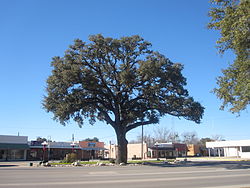Pleasanton, TX
| Pleasanton, Texas | |
|---|---|
| City | |

Giant oak tree in Downtown Pleasanton across from "Mr. Cowboy" sculpture
|
|
 Location of Pleasanton, Texas |
|
 |
|
| Coordinates: 28°58′1″N 98°29′6″W / 28.96694°N 98.48500°WCoordinates: 28°58′1″N 98°29′6″W / 28.96694°N 98.48500°W | |
| Country |
|
| State |
|
| County | Atascosa |
| Government | |
| • Type | Council-Manager |
| • City Council |
Mayor Clinton J. Powell Douglas Best Abraham Saenz, Jr. Diana K. Prasifka Eliseo Flores Robert Earl Wood Travis Hall |
| • City Manager | Bruce E. Pearson |
| Area | |
| • Total | 8.5 sq mi (22 km2) |
| • Land | 8.5 sq mi (22 km2) |
| • Water | 0.0 sq mi (0 km2) |
| Elevation | 361 ft (110 m) |
| Population (2010) | |
| • Total | 8,934 |
| • Density | 1,100/sq mi (410/km2) |
| Time zone | Central (CST) (UTC-6) |
| • Summer (DST) | CDT (UTC-5) |
| ZIP code | 78064 |
| Area code(s) | 830 |
| FIPS code | 48-58280 |
| GNIS feature ID | 1375500 |
| Website | www |
Pleasanton is a city in Atascosa County, Texas, United States. The population was 8,934 at the 2010 census. Pleasanton's official motto is "The City of Live Oaks and Friendly Folks." It is part of the San Antonio-New Braunfels Metropolitan Statistical Area.
Pleasanton honors its cowboy heritage with the "Mr. Cowboy" sculpture in front of City Hall and across from the giant oak tree downtown. The roots of the cattle kingdom can be traced to Atascosa County in the 1860s, which calls itself "the birthplace of the cowboys." The sculpture is a gift of Ben and Mona Parker. The Longhorn Museum in east Pleasanton on Highway 97 contains artifacts and memorabilia of the cowboy years. The Cowboy Homecoming, begun in 1966, is an annual event held at the Atascosa River Park in Pleasanton.
Pleasanton was established in 1858 when conflicts with the Indians caused the settlers to move the location of the county seat from Amphion. The settlers chose the current town site because of its location at the mouth of Bonita Creek. John Bowen (died 1867), San Antonio's first Anglo-American postmaster, founded and named the town of Pleasanton after his good friend and fellow early Texas Settler John Pleasants.
At one time Pleasanton had two newspapers, the Pleasanton Picayune, which became the Pleasanton Express in 1909, and the Pleasanton Reporter. The county seat was relocated from Pleasanton to Jourdanton in 1910. Pleasanton was incorporated in 1917.
Along with San Antonio, Uvalde, Crystal City, Carrizo Springs, and Corpus Christi, Pleasanton was a major stop on the now-defunct San Antonio, Uvalde and Gulf Railroad, which operated from 1909 until it was merged into the Missouri Pacific Railroad in 1956. The rail headquarters was located in a modern two-story depot in North Pleasanton beginning in 1913. However, headquarters closed in 1926, and later the SAU&G, or the Sausage Line as it was called, was merged into the Missouri Pacific. The headquarters depot has been razed, but an earlier depot in Pleasanton is displayed at the Longhorn Museum. The remaining San Antonio-to-Corpus Christi freight line is under the Union Pacific system.
...
Wikipedia
